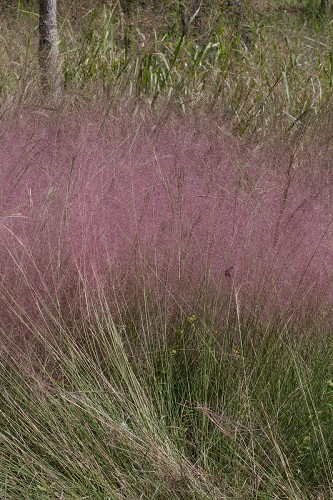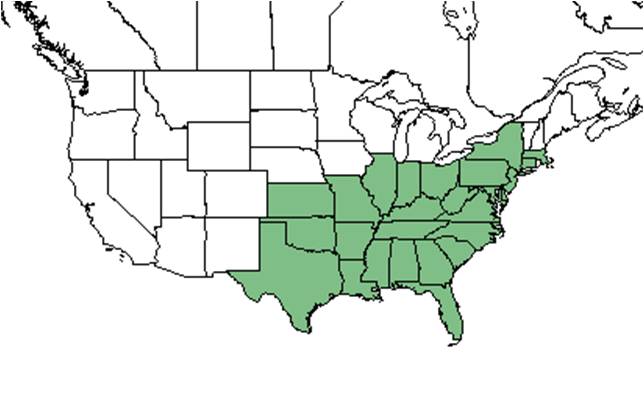Difference between revisions of "Muhlenbergia capillaris"
Krobertson (talk | contribs) |
|||
| Line 24: | Line 24: | ||
==Description== | ==Description== | ||
<!-- Basic life history facts such as annual/perrenial, monoecious/dioecious, root morphology, seed type, etc. --> | <!-- Basic life history facts such as annual/perrenial, monoecious/dioecious, root morphology, seed type, etc. --> | ||
| − | "Perennials. Blades usually scaberulous on both surfaces and margins; sheath margins scarious, at least apically; ligules scarious, erose or erose-ciliate. Spikelets 1-flowered. Glumes equaling or shorter than lemmas, lemmas not indurate. Grain enclosed by lemma and palea at maturity." | + | "Perennials. Blades usually scaberulous on both surfaces and margins; sheath margins scarious, at least apically; ligules scarious, erose or erose-ciliate. Spikelets 1-flowered. Glumes equaling or shorter than lemmas, lemmas not indurate. Grain enclosed by lemma and palea at maturity." <ref name="Radford et al 1964">Radford, Albert E., Harry E. Ahles, and C. Ritchie Bell. Manual of the Vascular Flora of the Carolinas. 1964, 1968. The University of North Carolina Press. 107. Print.</ref> |
| − | "Cespitose perennial; culms 5-12 dm tall, nodes and internodes glabrous. Leaves primarily basal; blades flat or involute, to 3 dm long, 103 mm wide; sheaths scaberulous; ligules 2-5 mm long. Panicle open, diffuse, delicate, 2-5 dm long, 1-2 dm broad; branches capillary, spreading, scaberulous. Spikelets usually purplish, lanceolate to narrowly ellipsoid, 4-5 mm long excluding awn; pedicels capillary, spreading, scaberulous. Glumes usually 1-nerved, usually scaberulous on midrib, scarious, 1st glume body 0.3-1.2 mm long, awn 0.3-1.2 mm long, 2nd glume body 1-1.5 mm long, awn 1-1.5 mm long; lemmas purplish, 3-nerved, scaberulous, body 3-4 mm long, awns 3-12 mm long; paleas purplish, faintly nerved, acuminate, 3-4 mm long. Grain purplish, narrowly ellipsoid, 2-2.4 mm long." | + | "Cespitose perennial; culms 5-12 dm tall, nodes and internodes glabrous. Leaves primarily basal; blades flat or involute, to 3 dm long, 103 mm wide; sheaths scaberulous; ligules 2-5 mm long. Panicle open, diffuse, delicate, 2-5 dm long, 1-2 dm broad; branches capillary, spreading, scaberulous. Spikelets usually purplish, lanceolate to narrowly ellipsoid, 4-5 mm long excluding awn; pedicels capillary, spreading, scaberulous. Glumes usually 1-nerved, usually scaberulous on midrib, scarious, 1st glume body 0.3-1.2 mm long, awn 0.3-1.2 mm long, 2nd glume body 1-1.5 mm long, awn 1-1.5 mm long; lemmas purplish, 3-nerved, scaberulous, body 3-4 mm long, awns 3-12 mm long; paleas purplish, faintly nerved, acuminate, 3-4 mm long. Grain purplish, narrowly ellipsoid, 2-2.4 mm long." <ref name"Radford et al 1964"/> |
==Distribution== | ==Distribution== | ||
==Ecology== | ==Ecology== | ||
| Line 44: | Line 44: | ||
</gallery> | </gallery> | ||
==References and notes== | ==References and notes== | ||
| − | |||
Revision as of 10:05, 3 August 2016
| Muhlenbergia capillaris | |
|---|---|

| |
| Photo by John R. Gwaltney, Southeastern Flora.com | |
| Scientific classification | |
| Kingdom: | Plantae |
| Division: | Tracheophyta- Vascular plants |
| Class: | Lilianeae -Monocotyledons |
| Order: | Poales |
| Family: | Poaceae |
| Genus: | Muhlenbergia |
| Species: | M. capillaris |
| Binomial name | |
| Muhlenbergia capillaris (Lam.) Trin. | |

| |
| Natural range of Muhlenbergia capillaris from USDA NRCS Plants Database. | |
Common names: Hairawn muhly
Contents
Taxonomic notes
Synonym: Muhlenbergia capillaris (Lam.) Trin. var. capillaris
Description
"Perennials. Blades usually scaberulous on both surfaces and margins; sheath margins scarious, at least apically; ligules scarious, erose or erose-ciliate. Spikelets 1-flowered. Glumes equaling or shorter than lemmas, lemmas not indurate. Grain enclosed by lemma and palea at maturity." [1]
"Cespitose perennial; culms 5-12 dm tall, nodes and internodes glabrous. Leaves primarily basal; blades flat or involute, to 3 dm long, 103 mm wide; sheaths scaberulous; ligules 2-5 mm long. Panicle open, diffuse, delicate, 2-5 dm long, 1-2 dm broad; branches capillary, spreading, scaberulous. Spikelets usually purplish, lanceolate to narrowly ellipsoid, 4-5 mm long excluding awn; pedicels capillary, spreading, scaberulous. Glumes usually 1-nerved, usually scaberulous on midrib, scarious, 1st glume body 0.3-1.2 mm long, awn 0.3-1.2 mm long, 2nd glume body 1-1.5 mm long, awn 1-1.5 mm long; lemmas purplish, 3-nerved, scaberulous, body 3-4 mm long, awns 3-12 mm long; paleas purplish, faintly nerved, acuminate, 3-4 mm long. Grain purplish, narrowly ellipsoid, 2-2.4 mm long." Cite error: Invalid <ref> tag;
invalid names, e.g. too many
Distribution
Ecology
Seed dispersal
According to Kay Kirkman, a plant ecologist, this species disperses by gravity. [2]